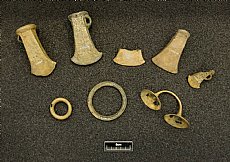The Poolewe Hoard
01 October 2020
- News Type:
- Find of the Month

In 1877, a Bronze Age hoard of nine copper alloy artefacts were recovered while peat cutting near Poolewe, Highland (Jolly 1879-1880, 46). These objects included five complete and incomplete socketed axes, three rings, and an object referred to as a “cup-ended ornament”, an object that may have functioned as a cloak fastener or decorative adornment. Based on typological assessment the hoard was probably deposited during the British Llyn Fawr metalworking assemblage (800-600 BC). It is the only secure hoard from this period in Scotland.
Recent reassessment of the hoard has provided interesting insights into its dating, production and deposition (Knight et al. forthcoming). Firstly, the wooden haft of one of the socketed axeheads survives and produced a radiocarbon date of 800–560 cal BC at 95% confidence, or 790–760 BC at 68% confidence. This suggests the hoard was deposited in the early 8th century BC, which conforms with the expected stylistic date of the socketed axeheads. Study of the condition on the axeheads suggests most, if not all, were used as functional tools prior to deposition. At least two would still have been usable, though one had been deliberately fragmented.
The cup-ended ornament poses an interesting perspective on the dating. This object form was typically produced in gold between 1000-800 BC. Other notable examples include those in the hoard of gold ornaments from Heights of Brae, Highland (Clarke and Kemp 1984). The production of the Poolewe ornament in bronze is very rare and if it were produced and used between 1000-800 BC, it could have been several years, or even decades, old when deposited. It was probably a treasured object. The presence of an older object, as well as the mixed condition of the axeheads, suggests that the hoard was perhaps accumulated over time before it was buried in a peat bog.
Metallurgical analysis supports this theory. The objects were produced from five ‘pools’ of metal, which suggests that the objects were produced at different times and there were multiple supplies of bronze entering the supply system in Scotland around this time, much of it from continental Europe. These are important observations as they run against the traditional view of the collapse of metal supplies around 800 BC.
We now recognise that around this time there was a broader change in social and cultural perceptions relating to bronze and hoarding practices (Needham 2007; O’Connor 2007). New forms of bronze objects continued to be produced and deposited, as indicated by single finds of axeheads, swords and razors, as well as remains of metalworking workshops, but people seemingly stopped burying hoards in Scotland. By contrast, over 60 hoards were deposited during the period 1100-800 BC (Coles 1959-1960). The deposition of the Poolewe hoard between 800-750 BC, perhaps accumulated over a period of time, may represents the last vestiges of Late Bronze Age hoarding practices in Scotland at a time when ideologies were changing.
The Poolewe hoard will be published in full in the Archaeological Journal later this year.
Further Information
Clarke, D V and M M B Kemp 1984 ‘A Hoard of Late Bronze Age Gold Objects From Heights of Brae, Ross and Cromarty District, Highland Region’, Proceedings of the Society of Antiquaries of Scotland 114, 189–198.
Coles, J M 1959-1960 ‘Scottish Late Bronze Age metalwork: Typology, distributions and chronology’, Proceedings of the Society of Antiquaries of Scotland 93, 16–134.
Jolly, W. 1879-1880 ‘Notes on Bronze Weapons and Other Remains Found near Poolewe, Ross-Shire’, Proceedings of the Society of Antiquaries of Scotland 14, 45–49.
Knight, M G, Boughton, D and Northover, J P forthcoming ‘Poolewe: The last Bronze Age hoard in Scotland?’, Archaeological Journal
Needham, S P 2007 ‘800BC: The Great Divide’, in Haselgrove, C and Pope, R (eds) The Earlier Iron Age in Britain and the Near Continent, Oxbow Books: Oxford, 39–63.
O’Connor, B 2007 ‘Llyn Fawr Metalwork in Britain: A Review’, in Haselgrove, C and Pope, R (eds) The Earlier Iron Age in Britain and the Near Continent, Oxbow Books: Oxford, 64–79.
Historic Environment Record MHG7755
Contributed by Matt Knight
Find of the Month Archive
- 25/07/2022 Steatite Vessels
- 10/04/2021 Cruisie lamp in Dunrobin Castle Museum
- 02/03/2021 Medieval Sword Pommel from Sleat, Skye
- 01/02/2021 Hilton of Cadboll Pictish Cross Slab
- 04/01/2021 Gunflint from Stoneyfield, Inverness
- 02/12/2020 Bobbin from Contin Bobbin Mill
- 02/11/2020 Russian Lead Cloth Seal from Cromarty
- 01/10/2020 The Poolewe Hoard
- 04/09/2020 Storr Rock Viking Silver Hoard
- 07/08/2020 Mesolithic bloodstone artefacts from Camas Daraich, Skye
